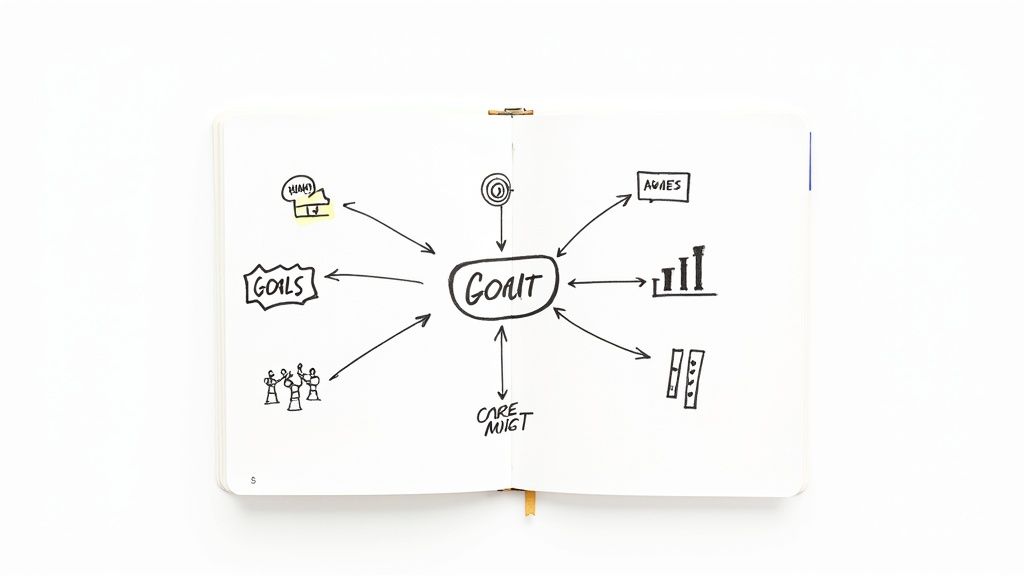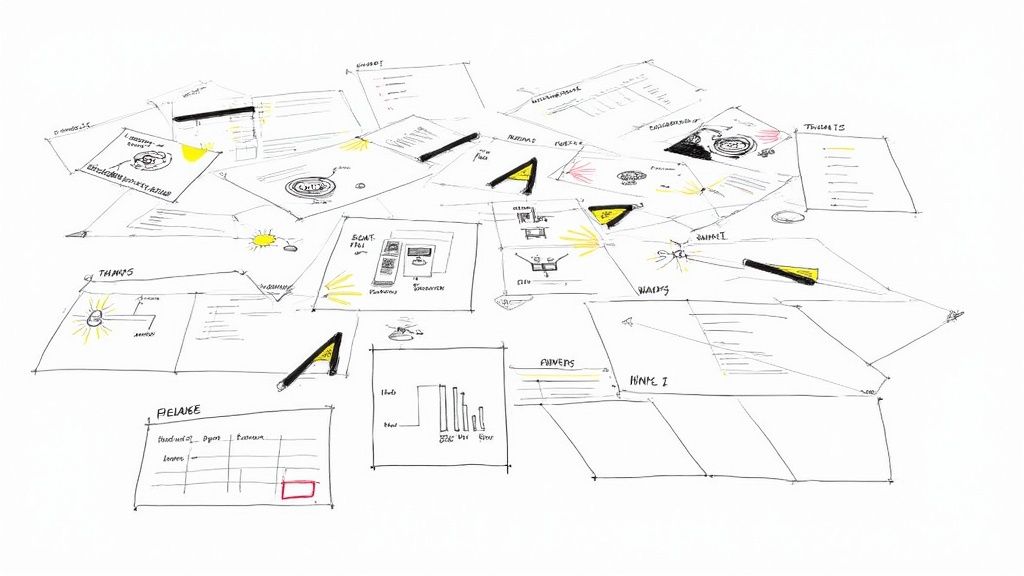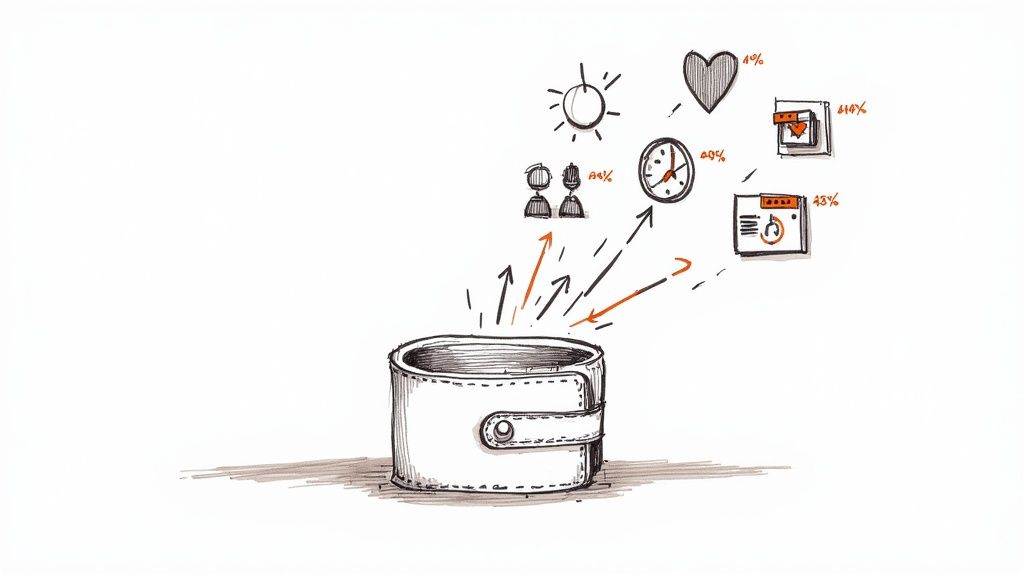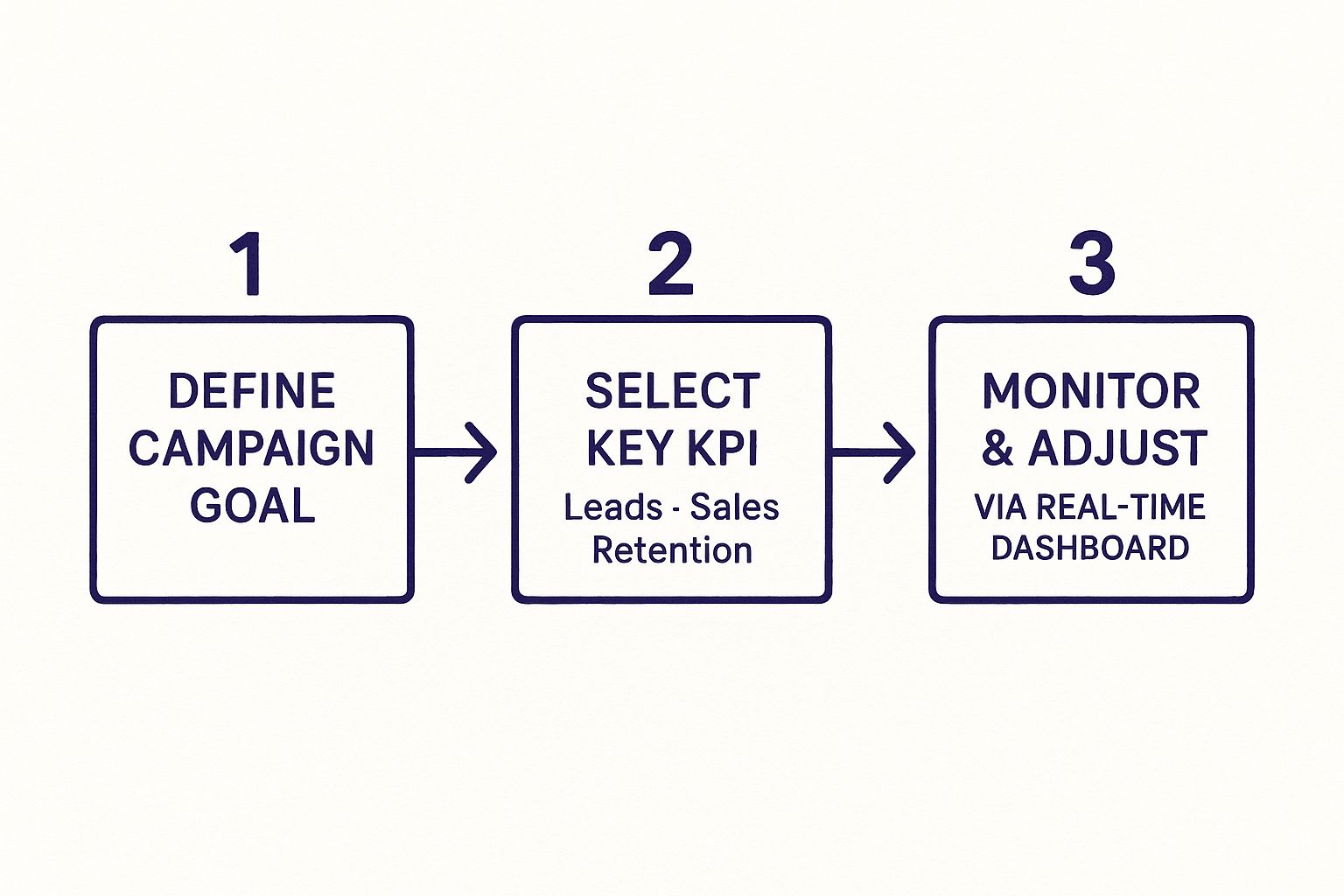
Mastering Lead Generation for Healthcare: Proven Strategies for 2025
Master lead generation for healthcare with proven strategies for 2025. Learn to attract, nurture, and convert quality leads in the complex healthcare market.

A marketing campaign planning template is your project’s command center. It’s the foundational blueprint that turns ambitious ideas into real, measurable results, saving you from costly guesswork and last-minute chaos. This isn't just another document; it’s the tool that gets everyone, from creative to sales, moving in the same direction.
Too many marketing campaigns feel like a mad dash to the finish line. A solid planning template is what separates frantic pushes from predictable, strategic success. It acts as the single source of truth, aligning your entire team on goals, responsibilities, and deadlines from the start.

This isn’t about just ticking off boxes. It's about building a framework that turns abstract concepts into tangible outcomes. A well-crafted template boosts success rates by aligning teams, managing budgets, and setting clear timelines before you launch. Without a plan, even brilliant creative ideas can fizzle out. A template brings everything—from brainstorming to execution and analysis—all in one place. For a deeper dive, check out this guide to campaign planning from Resolution.
When you clearly define roles and tasks in a template, there’s no room for ambiguity. Everyone knows exactly what they’re responsible for and when it’s due. This clarity builds a culture of ownership. For example, the content writer knows the blog post deadline, the designer sees when visuals are needed, and the social media manager has a clear posting schedule. It’s all laid out.
A great template doesn't just list tasks; it connects individual contributions to the campaign's ultimate success. This link drives motivation and ensures nothing slips through the cracks.
Ultimately, this document ensures every dollar and hour is spent driving toward a clear definition of success, leading to more predictable and impactful results.
A marketing campaign plan, no matter how detailed, is just a map without a destination. Before you think about content or channels, you must be crystal clear on two things: what "success" actually looks like, and who you are trying to talk to. Vague goals like "get more engagement" are a recipe for wasted effort. You need to be specific, thinking in terms of real numbers and deadlines.
For example, instead of a fuzzy goal like "boost brand awareness," you'd want something concrete: "Increase brand mentions on LinkedIn by 25% among marketing managers in the SaaS industry by the end of Q3." See the difference? Now you have a clear target to aim for, which informs every decision you make.
Once you know what you want to achieve, zero in on who you're talking to. Don't just jot down basic demographics. You need to build a buyer persona so detailed it feels like you're describing a real person. What are their biggest frustrations at work? What podcasts do they listen to? Where do they hang out online for advice?
The campaigns that really hit home are the ones that feel like they're speaking to one person's specific problems and dreams. If you try to talk to everyone, you usually end up connecting with no one.
Knowing these details allows you to craft a message that genuinely resonates. If your persona is a project manager buried in inefficient workflows, they're far more likely to click on an article about productivity hacks than a generic product announcement. This upfront research is the bedrock of any successful campaign. It puts the "data" in data-driven marketing. To learn more, check out our guide on what is data-driven marketing.
If your campaign goals are the destination, your core message is the GPS. This message needs to be sharp, memorable, and answer your audience's unspoken question: "What's in it for me?" Think of it as the central idea that ties every piece of your campaign together.

This is where you nail down your unique value proposition. Let's say you're reaching busy small business owners. Your message could be about saving them 10 hours a week with your new software. Every blog post, ad, and email should echo that specific promise. Once you have that message locked in, build out your content plan. Many campaigns fall flat because there was no plan.
You can't just throw content out there and hope it sticks. Create specific assets that meet your audience where they are in their decision-making process.
Awareness Stage: They're just realizing they have a problem. Your job is to educate, not sell. Think helpful blog posts, quick "how-to" videos, or shareable infographics that address their pain points.
Consideration Stage: Now they're actively looking for a solution. Introduce your brand as the answer. Case studies, in-depth guides, and product comparison sheets work beautifully here.
Decision Stage: They're ready to buy but need a final nudge. Offer free trials, live demos, and glowing customer testimonials to build trust and seal the deal.
Feeling stuck on content ideas? You can explore the best free AI tools for content creation to get started. We also have a guide on how to use AI in marketing that dives deeper into this.
You could have the most amazing message, but it won't matter if the right people never see it. This is where you choose your channels, figure out the budget, and set a realistic timeline. It's about building the bridge between your message and your audience.

Picking marketing channels isn’t about being on every platform. It's about showing up where your customers spend their time. If your research shows they listen to industry leaders on LinkedIn, focus your efforts there—not on making a viral TikTok video. Go where the conversation is already happening.
Your budget turns ideas into reality. Break it down by channel and activity. For a new product launch, your budget might look like this:
This detailed breakdown gives you control and helps you make data-driven decisions. Building specific KPIs and budget lines into your template is a pro move that makes tracking performance easier. You can dig deeper into building an effective campaign template on camphouse.io for more on this.
A detailed budget is your campaign’s financial roadmap. It transforms your strategy into an action plan and ensures every dollar has a purpose tied to your goals.
How do you know if your campaign worked? The proof is in the numbers, but you have to track the right ones. It's time to look past vanity metrics like social media likes and get to what really moves the needle. Your marketing campaign planning template needs a section for Key Performance Indicators (KPIs) that tie directly to your main objectives. If your goal is to generate leads, your world revolves around cost per lead (CPL) and your conversion rate. If it's all about sales, Return on Ad Spend (ROAS) is your guide.
Don't fall into the trap of tracking everything. You'll drown in data. Pick a few core KPIs that tell the story of your campaign's performance.
Here’s how to break it down by goal:
A foundational part of this is knowing how to calculate marketing ROI. Thankfully, you don't have to do it all with a spreadsheet.
Using a marketing dashboard with automation is non-negotiable today. These tools pull all your data into one place and provide real-time insights, cutting down manual reporting time significantly. You can see examples of pre-built marketing dashboards on improvado.io.
This data-driven approach isn't just for the final report; it lets you make smart adjustments while the campaign is running. To learn more, check out our guide on how to calculate marketing ROI.
Theory is great, but execution is where the magic happens. Here, we turn these concepts into a practical, repeatable process. The goal is to build a reliable workflow that eliminates guesswork and lets your team focus on what matters. Think of your marketing campaign planning template as a living roadmap, not a static document. This structured thinking separates a chaotic scramble from predictable success.
To make this straightforward, I've boiled the process down to its core steps. Following this flow ensures you never skip a critical piece of the puzzle. The infographic below lays out the essential decision-making loop for successful campaigns.

What this visual drives home is that crucial feedback loop. Campaign management is never a "set it and forget it" activity.
The most effective campaigns are built on a cycle: define a clear goal, measure progress with the right KPIs, and adjust the strategy based on what the data tells you. Agility is your biggest advantage.
By following this action plan, you're not just launching one successful campaign. You're building a system that gets smarter with every one you run.
Even with the perfect template, questions pop up. Let's tackle the most common ones.
Treat your template like a living document. A good rule is to revisit it after every major campaign. Get the team together for a post-mortem. What worked? What was a headache? Maybe you realize you need a section for influencer outreach tracking. Add it for the next round. This constant refinement makes the template truly your own.
Absolutely. The secret is to adapt it, not just adopt it. If you're a small team, you probably don't need a multi-tab budget tracker. Don't be afraid to delete or hide the sections that don't serve you. The goal isn't to check every box; it's to create a structure that brings order to your chaos. A stripped-down template that fits your workflow is better than a comprehensive one you never use.
The biggest mistake is treating a template like a rigid checklist. Think of it as a flexible framework instead. The best marketing campaign planning template is the one you actually use.
This mindset makes the template work for you, not the other way around. It helps you stay organized without drowning in busywork.
Ready to stop guessing and start building campaigns that move the needle? The team at BrandBooster.ai uses smart AI and battle-tested strategies to create marketing plans that deliver real, measurable growth.